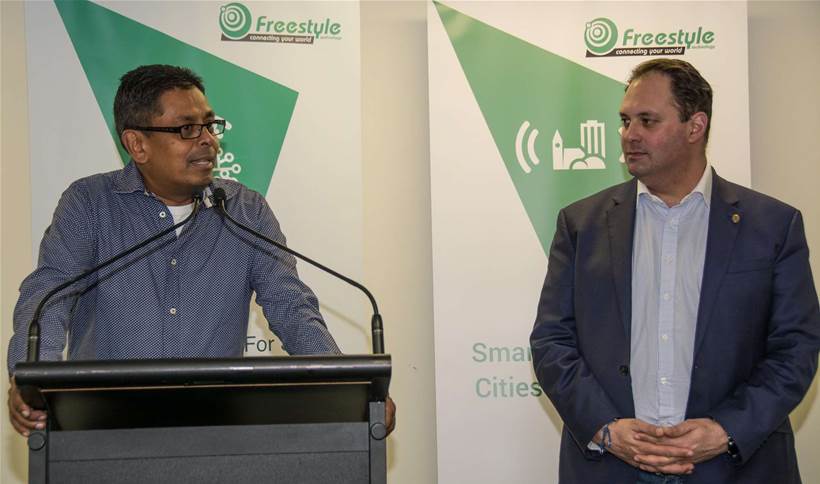Freestyle Technology is an Australian company enjoying international success in the Internet of Things industry, and now the local economy is benefitting from that success with the establishment of a new IoT research and development centre in Mount Waverly, Victoria.
The company says the facility will play a central role in its efforts to establish its technology as the global standard for applying IoT innovation in the water, gas and electricity utilities sector.
Managing director Mohan Jesudason said: “We’ve invested more than $45 million in developing our innovative IoT solutions and customer base in Asia – and we project generating more than 150 high-tech jobs and exports in excess of $200 million in the next few years.”
Freestyle Technology is an IoT integrator that takes a ‘comms and device agnostic’ approach to connecting devices and systems. Its Freestyle Microengine software platform and cloud-based machine-to-machine (M2M) switch management platform are used to connect and manage IoT devices.
Among its Asian clients is Chunghwa Telecom. Freestyle Technology helped to develop the management solution that allowed the Taiwanese telco’s gas company clients to securely access and manage their assets, including smart meters, gas pipeline equipment, and CO2, fire and smoke sensors.
Freestyle’s plans
Now, with the announcement of its Mount Waverly R&D facility, the company aims to build on its international success.
Jesudason sat down with IoT Hub to discuss the company’s future and his thoughts on the IoT industry generally.
After successful stints at Tabcorp Holdings and Telecom Corporation of New Zealand, Jesudason came on-board with Freestyle in August 2013.
“I first spent a bit of time in the company looking at the broader M2M sector and where the next evolution of the internet was going, and then set about commercialising what I thought was a unique offering,” he said.
He said that despite the shift in terminology from M2M to IoT, Freestyle’s focus hasn’t changed.
“We’ve always started things from the customer perspective, and technology, IoT and the disruptions that they bring are just a means to end, as far as we’re concerned,” he said. “Our conversations with the customer is about solving business problems, and that’s how we’ve always operated.
“What has changed is that the customer now understands the role that IoT plays in their business models, they understand the difference in cost structures that it can bring, and they understand what IoT is capable of achieving, in terms of predicting behaviours and data analytics.”
Jesudason hopes that Freestyle’s success in providing utilities solutions can lead to derivative use cases and other applications of the company’s technologies.
“When you look at the utilities sector, it’s very large to the extent that it’s water, electricity and gas. But then you look at the adjacencies that branch out from there, and you get into street lighting, waste management, sewerage management,” he said.
“From there, it’s only a small step to traffic management and the whole concept of smart cities.”
Local market starting to catch up
Jesudason noted that while Australia and New Zealand still lag the rest of the Asia-Pacific region with IoT adoption, there are signs of improvement.
“In Australia and New Zealand, we are also seeing a good level of activity; not at the same level as we are seeing in the Asian region, which has been paying this space a lot of attention for a number of years.
“Having said that, over the last 12 months we’ve certainly seen an uptick in activity in the Australian market.”
And that will a flow-on impact on the rest of the economy. “In addition to the core IoT connectivity space, there’s a broader ecosystem that sees connected platforms as being part of future growth, whether it be systems integrators or value-added resellers, or OEMs and the like,” he said.
What’s next?
Jesudason likens the Internet of Things to a pyramid. “At the top end, you’ve got big factories and aircraft engines, for which the cloud as a management device is perfectly suitable,” he said.
“At the bottom end are billions of devices sending small bits of data at various intervals of frequency, for which the cloud could be quite expensive, and device-side processing would be preferred.”
Jesudason said that IoT is “a revolution that is here now” and sees every vertical market as capable of taking advantage of IoT.
“If you consider at the role of the internet over the last few decades, you can’t really picture life without it, and is prevalent in just about every dimension you can think of,” he said.
“IoT can be a part of every walk of life, from healthcare to aged care to soluble chips for patient diagnosis, to wearable devices and automation.”







